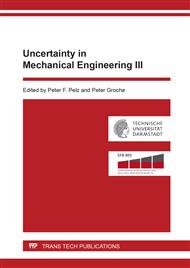[1]
H. Hanselka, R. Platz, Ansätze und Maßnahmen zur Beherrschung von Unsicherheit in lasttragenden Systemen des Maschinenbaus, In Konstruktion. November/Dezember 2010, S. 55-62.
Google Scholar
[2]
T. Freund, Konstruktionshinweise zur Beherrschung von Unsicherheit in technischen Systemen, Dissertation, Technische Universität Darmstadt, Fachgebiet für Produktentwicklung und Maschinenelemente, (2018).
Google Scholar
[3]
T. Eifler, Modellgestützte Methodik zur systematischen Analyse von Unsicherheit im Lebenslauf technischer Systeme, Dissertation, Technische Universität Darmstadt, Fachgebiet für Produktentwicklung und Maschinenelemente, (2014).
Google Scholar
[4]
R. Kühnpast, Das System der selbsthelfenden Lösungen in der maschinenbaulichen Konstruktion, Dissertation, Technische Hochschule Darmstadt, Fachgebiet für Maschinenelemente, (1968).
Google Scholar
[5]
S. Mallapur and R. Platz, Quantification and evaluation of uncertainty in the mathematical modelling of a suspension strut using bayesian model validation approach,, in Model Validation and Uncertainty Quantification, Volume 3 (Barthorpe Robert J., R. Platz, I. Lopez, B. Moaveni, and C. Papadimitriou, eds.), Conference proceedings of the Society for Experimental Mechanics series, (Cham), p.113{124, Springer International Publishing, (2017).
DOI: 10.1007/978-3-319-54858-6_12
Google Scholar
[6]
T. Eifler, G. C. Enss, M. Haydn, L. Mosch, R. Platz, H. Hanselka, Approach for a Consistent Description of Uncertainty in Process Chains of Load Carrying Mechanical Systems. In: Applied Mechanics and Materials. Vol. 104, pp.133-144. (2011) Trans Tech Publications.
DOI: 10.4028/www.scientific.net/amm.104.133
Google Scholar
[7]
D. D. Woods, Essential Characteristics of Resilience, in: E. Hollnagel, D. Woods and N. Leveson, (Ed.), Resilience Engineering – Concepts and Precepts, Ashgate, transferred to digital printing in 2010, Farnham, pp.21-34.
DOI: 10.1201/9781315605685
Google Scholar
[8]
E. Hollnagel and D. D. Woods, Epilogue: Resilience Engineering Precepts, in: E. Hollnagel, D. D. Woods and N. Leveson (Ed.), Resilience Engineering – Concepts and Precepts, Ashgate, transferred to digital printing in 2010, Farnham, pp.347-358.
DOI: 10.1201/9781315605685-30
Google Scholar
[9]
J. Würtenberger, S. Gramlich, T. Freund, J. Lotz, M. Zocholl, H. Kloberdanz, Uncertainty in product modelling within the development process, In Applied Mechanics and Materials. Vol. 807, pp.89-98, Trans Tech Publications.
DOI: 10.4028/www.scientific.net/amm.807.89
Google Scholar
[10]
L. Altherr, N. Brötz, I. Dietrich, T. Gally, F. Geßner, H. Kloberdanz, P. Leise, P. Schlemmer and A. Schmitt, Resilience in Mechanical Engineering – A Concept for Controlling Uncertainty during Design, Production and Usage Phase of Load-Carrying Structures, In Applied Mechanics and Materials. Trans Tech Publications. Under review.
DOI: 10.4028/www.scientific.net/amm.885.187
Google Scholar
[11]
K. Tierney and M. Bruneau, Conceptualizing and measuring resilience: A key to disaster loss reduction, TR News 250 (2007).
Google Scholar
[12]
J. Mathias, H. Kloberdanz, R. Engelhardt and H. Birkhofer, Strategies and Principles to design robust products, Proceedings of the DESIGN 2010 / 11th International Design Conference, Dubrovnik, Croatia, May 17-20, 2010, pp.341-350.
Google Scholar
[13]
Pahl, G., Beitz, W., Feldhusen, J. and Grote K. H. (2007), Engineering Design: A Systematic Approach, third Edition, Springer London.
Google Scholar
[14]
S. Jackson, Evaluation of Resilience Principles for Engineered Systems, PhD thesis, University of South Australia, (2016).
Google Scholar
[15]
S. Jackson, Architecting Resilient Systems: Accident Avoidance and Survival and Recovery from Disruptions, Wiley, Hoboken, (2009).
Google Scholar
[16]
A. M. Madni and S. Jackson, Towards a Conceptual Framework for Resilience Engineering, IEEE Systems Journal, July 2009.
Google Scholar
[17]
D. D. Woods and E. Hollnagel, Prologue: Resilience Engineering Concepts, in: E. Hollnagel, D. D. Woods and N. Leveson, (Ed.), Resilience Engineering – Concepts and Precepts, Ashgate, transferred to digital printing in 2010, Farnham, pp.1-6.
DOI: 10.1201/9781315605685-1
Google Scholar
[18]
J. Feldhusen, K.-H. Grote, G. Pahl, W. Beitz, eds., Pahl/Beitz Konstruktionslehre: Methoden und Anwendung erfolgreicher Produktentwicklung. 8. vollst. überarb. Aufl., Springer Verlag, Berlin, Heidelberg (2013).
DOI: 10.1007/978-3-642-29569-0_12
Google Scholar
[19]
Z. Sun, G.S. Yang, B. Zhang and W. Zhang, On the Concept of Resilient Machine. 6th IEEE Conference on Industrial Electronics and Applications 2011, 978-1-4244-8756-1/11.
Google Scholar
[20]
H. Meffert, Zum Problem der betriebswirtschaftlichen Flexibilität. Zeitschrift für Betriebswirtschaft, 1969, vol. 39, no. 12, pp.779-800.
Google Scholar
[21]
C. M. Gehb, R. Platz, and T. Melz, Active load path adaption in a simple kinematic load-bearing structure due to stiffness change in the structure's supports, Journal of Physics: Conference Series, vol. 744, no. 1, p.012168, (2016).
DOI: 10.1088/1742-6596/744/1/012168
Google Scholar
[22]
C. M. Gehb, R. Platz, and T. Melz, Global load path adaption in a simple kinematic load-bearing structure to compensate uncertainty of misalignment due to changing stiffness conditions of the structure's supports, in: Model Validation and Uncertainty Quantification, Volume 3 (Barthorpe Robert J., R. Platz, I. Lopez, B. Moaveni, and C. Papadimitriou, eds.), Conference proceedings of the Society for Experimental Mechanics series, (Cham), pp.133-144, Springer International Publishing, (2017).
DOI: 10.1007/978-3-319-54858-6_14
Google Scholar
[23]
Y. Y. Haimes, Y. Y., On the Definition of Resilience in Systems. Risk Analysis, 2009, Vol. 29, No. 4, pp.498-501.
Google Scholar


